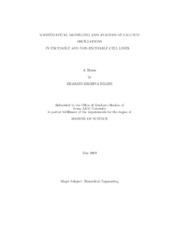| dc.description.abstract | Information is transmitted from the cell surface to various specific targets in the cell via several cellular signaling pathways. Cytosolic free calcium (Ca2+)is one of
the most versatile and ubiquitous intracellular messengers since it is able to regulate
diverse number of functions such as proliferation, secretion, fertilization, metabolism,
learning and memory. In the last couple of years, evidence has been accumulating
that Ca2+ ion is able to integrate information from multiple signaling pathways and
convert this information into a code which regulates events ranging from contraction
to modification of gene expression (Berridge et al. 1998). It was shown that Ca2+
concentration displays oscillatory behavior in response to agonist stimulation in a
variety of cells(Goldbeter 1996) and the frequency of these oscillations increases with
the concentration of agonist, a behavior called frequency encoding which has led to the
concept that many Ca2+-regulated processes are controlled by these codes(Berridge
1998).
Although the presence of Ca2+ oscillations and the sources of Ca2+ pools involved
is known in many cell types, it is yet not known how the various frequencies of
Ca2+ oscillations are converted into codes that regulate the numerous cellular events.
Recently a number of cellular targets that decode Ca2+ signals and are tuned to
the frequency of Ca2+ oscillations have been identified. Prominent among them are calcium-calmodulin kinase II (CAM II) and protein kinase C (PKC).
The objective of this work is to study and mathematically model the oxytocin
and vasopressin-induced Ca2+ oscillations in cells of normal rat liver (Clone 9) and
cells of pregnant human myometrium. The proposed model accounts for the receptor-controlled
Ca2+ oscillations involving positive feedback leading to activation of phospholipase
C (PLC) and negative feedback from PKC onto G-proteins which simulates
many of the features of observed intracellular Ca2+. The model also incorporates
the concept that coordinated Ca2+ signals in a group of hepatocytes require both
effective gap junctions and the presence of agonist at each cell surface. Another objective
of this research is to understand the relevance of frequency-encoded signals
by performing an analysis of frequencies of Ca2+ oscillations using the Fast Fourier
Transform and the Wavelet Transform. The validity of the model was confirmed by
using statistical tests to check if the frequencies and amplitudes of the experimental
Ca2+ oscillations match with those of the modelled oscillations. | en |


